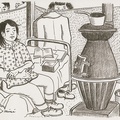The sudden onset of World War II on December 7, 1941, thrust the issue of identity to the forefront for all Japanese Americans. On February 19, 1942, President Franklin D. Roosevelt signed Executive Order 9066 authorizing the War Department to prescribe military areas from which any or all persons might be excluded. This order served as the basis for Lt. Gen. John L. DeWitt to issue the curfew and exclusion orders. Public Proclamation No. 3 established a curfew from 8:00 P.M. to 6:00 A.M. for Japanese Americans in Military Area No. 1, which covered the western portions of Washington, Oregon, and California, and the southern portion of Arizona. The curfew required them to stay within a five-mile radius of their homes. The implementation of the exclusion order began on March 24, 1942, and by October 1942, all Japanese Americans were removed from the West Coast and incarcerated in hastily constructed concentration camps, also known as relocation centers. 1
Early in 1943, the War Department and the War Relocation Authority devised a questionnaire to test the loyalty of persons aged seventeen years and older in all camps. The purpose was to sort out the “loyals” from the “disloyals.” The questionnaire included two critical questions, numbers 27 and 28, which asked: “Are you willing to serve in the armed forces of the United States on combat duty, wherever ordered?” and “Will you swear unqualified allegiance to the United States of American and…forswear any form of allegiance or obedience to the Japanese emperor…?”2 Answering “yes” to these questions was mandatory for those applying for resettlement out of camp to areas of the United States outside of the West Coast exclusion zones. It also made male Nisei of draft age eligible for conscription into the armed services. Beginning in February 1943, the army scheduled visits to the camps to register all male Nisei of draft age. 3
The exclusion of all Japanese Americans from the West Coast and the conscription of Japanese Americans into the United States Army led to diverse reactions on the part of four Nisei cousins who were raised in Japanese American communities in and around Seattle, Washington. 4 The cousins are Grant Jiro Hirabayashi, Gordon Kiyoshi Hirabayashi, Robert Taro Mizukami, and Henry Nobuo Hirabayashi. They are the sons of Issei immigrants from an extended family neighborhood of eleven Hirabayashi households in the township of Hotaka, Nagano prefecture, Japan. Toshiharu Hirabayashi, father of Grant; Shungo Hirabayashi, father of Gordon; Isami (née Hirabayashi) Mizukami, mother of Robert; and Hamao Hirabayashi, father of Henry, were the relatives who emigrated to America.
The primary theme of this essay is Japanese American identity formation. It examines the nature of Nisei identities as Japanese Americans and Americans and how these issues impacted the decisions they made as Americans. It concludes with a discussion of ethnic identity formation in America and implications for America as a democratic and multicultural society. This essay considers the Hirabayashi cousins’ family and community backgrounds, presents vignettes of their lives prior to the war, and describes their reactions and decision-making during the critical wartime period. With a common background, the four Nisei cousins identified as Japanese Americans, but they took different trajectories in response to the exigencies they faced during World War II. Each cousin, operating in terms of his own understanding of American citizenship, made independent decisions in response to challenges to his citizenship rights.
Immigrant families seeking security in an often-hostile land formed ethnic communities. In his classic study on the Japanese in the Seattle area, Frank Miyamoto points to a tightly knit social organization as being the key feature of the community: “almost every Japanese minority member seemed in some way linked to an elaborate social network in the Japanese community.” 5
Collective responsibility led to social solidarity. Miyamoto refers to the initial years of Issei immigration as the “frontier period”: “the population was composed largely of laboring-class males, almost all of whom were ‘birds of passage’ eager to make quick money and return to Japan. Families were few, and only the bare framework of the institutional organization necessary to the wants of a normal community was existent.” After the signing of the Gentlemen’s Agreement in 1907, the community entered what Miyamoto termed the “settling period”: “Families were emphasized…New institutions were necessitated to bridge the gap for the settling Japanese immigrants between their native heritage and the American environment.”6 It was a setting, however, characterized by racism: “prejudice and discrimination were much more manifest than they are today…it was caste-like.”
Nestled in the foothills of the Japan Alps in Nagano prefecture is the township of Hotaka. In a semi-rural setting at the edge of town was a cluster of eleven Hirabayashi households. In 1907, several young Issei from this extended kin group emigrated to the Seattle area, where they maintained close relationships with each other. “There had been an adventurous man in Azumi who had come to America, made a fortune in five years, and returned home…advertised America’s wealth and opportunities, and under his influence, these four young men made their decision to cross the ocean.” 7
In preparation for their overseas sojourn, several Issei cousins attended a private academy, Kensei Gijuku, in order to learn English. While there they converted to Christianity. The founder and principal of the school, Iguchi Kigenji, was a disciple of Uchimura Kanzo, the founder of Mukyokai (Non-church Christian movement) in Japan. 8
The Mukyokai movement repudiated institutionalized church structures and sectarian animosities. It instead advocated the equality of believers and established fellowships (Kyoyu Kai) devoted to living a Christian life, nurturing faith and morals, engaging in the study of the scriptures, and looking after the welfare of fellow members. 9
Upon arrival in America the Issei cousins worked on railroad crews. They subsequently moved to Seattle and found work in hotels, restaurants, and stores. Some became small entrepreneurs, and others turned to farming. Several cousins, along with friends from Nagano prefecture, began a vegetable garden that later became the site of the Sand Point Naval Air Station, just a few miles east of the University of Washington campus in Seattle. They peddled their vegetables at the Pike Place Market above the Seattle waterfront, hauling their produce by horse and wagon. After a few years the Issei cousins sent for their Japanese brides, and they began families. They formed an extended family group and saw to each other’s social and economic needs.
Together with fellow immigrants from Hotaka township in Nagano, the Issei cousins established a Hotaka Club in Seattle. They kept in close contact with each other and met regularly throughout the year on holidays and other special occasions. They even invited Caucasian acquaintances from the neighborhood to picnic gatherings. In addition to the Hotaka Club, the Issei cousins belonged to the Nagano Prefectural Association, a social and mutual aid association. They also belonged to the Japanese Association of North America, a social and political organization established to look out for the interests of all immigrant Japanese in the Seattle area.
In 1919, four Issei from Nagano prefecture, including two of the Hirabayashi cousins, moved their families to Thomas, Washington, a rural community twenty miles south of Seattle. They purchased forty acres of land in the name of the eldest Nisei child in the group and began to develop their property. In the early 1920s, John Isao Nishinoiri, a graduate student from Japan, was engaged in field research on Japanese farms for his M.A. degree in sociology at the University of Washington. He wrote:
Above five miles south of Kent on the west road leading to Auburn stand four neatly painted houses…this is the White River Gardens…{they}came from the same district in Japan, Azumi in Nagano prefecture…Although four different families live there, they plant, crop, buy and sell together. Machinery, tools, barns, horses and all equipment are owned and used in common. Cooperation is not a theory with them; it is a daily practice…This occupational cooperation finds its source in their spiritual cooperation…acquired in Japan under the influence of a non-denominational evangelist {which} binds them together closely…They maintain their simple Christian faith in its puritanical form…They do not work on Sunday even in the busiest seasons, and never fail to meet for the purpose of worshipping God. They have no minister, so each of them speaks in turn of his thoughts and experiences. Their simple service is opened and closed with hymns and prayer, and when I attended I felt as if I were sitting with the Puritans of the colonial period. 10
The Mukyokai Issei established relationships with local Christians. They joined with their Christian neighbors, both Japanese and Caucasian, to start the Union Sunday School in Thomas. The grade school annex was rented, and over fifty people attended each week: “Occasional pastor was Rev. Ulysses Grant Murphy from Seattle, a former missionary to Japan. {He} came up from Seattle once a month to preach to the group; in the evening he spoke in Japanese {to} the Thomas Kyoyukai – Friends of Jesus Society.” 11
The White River Gardens families cleared their land, began raising crops, and in successive years built houses for each of the families. In 1922, Malcolm Douglas, prosecuting attorney for King County, claimed the land was in control of alien Japanese and in violation of the Alien Land Act of 1921, which prevented noncitizens from owning land. He filed suit, claiming: “Wherefore, the plaintiff prays that this court enter a decree herein declaring that said land is forfeited and escheated to the State of Washington, and that the defendants have no right, title or interest therein.” 12 Although the land title was held by a Nisei, the government contended the Issei were really in charge. The Washington Supreme Court ruled against the families, who were then forced to lease the houses and land they had built and improved from the State of Washington. “They continue their humble life and hard work and quiet prayer in spite of the uncertainty of their position.” 13
In spite of these hardships, they settled down, raised their children, and joined with others in community affairs primarily through the local Japanese Association. They wrote essays about their American lives in a journal titled Shin Kokyo (New Homeland), reflecting their attitudes towards their new homes and the transformation of their collective identities from being Japanese to being American. 14
From these intimate contacts, the Nisei learned about Issei conceptions of social relationships. The Nisei were in direct contact with mainstream society in their daily activities, but particularly with education institutions. The aim of the public schools was to socialize all students into becoming good citizens of the Republic.
The social context of the 1920s and 1930s was a complex setting for the Issei. The period included racism, economic hardships of the Depression era, and mounting political tensions resulting from Japan’s move to increase its hegemony in Asia. As the Nisei matured, they established their own communities, building on the influences of both the Issei and the mainstream society. A distinctive Nisei lifestyle appeared during this perid that was characterized by “the Nisei’s assimilation of the Japanese interpersonal style, modified to fit the American scene, and the resulting emergence of a Nisei culture and associative patterns with which the Nisei felt themselves especially comfortable.” 15
The education of the Nisei cousins included not only their Issei parents’ Mukyokai teachings but also exposure to mainstream Christianity through the Union Sunday School and the summer Vacation Bible School, which was located in Auburn, a town to the south of White River Gardens. As they grew older, the cousins also attended periodic meetings of the regional Japanese American Christians Association. This was a general pattern for the Christians in the Japanese American community. The church “established interpersonal ties of unusually enduring quality and also laid relational networks which spanned regional communities.” 16
There was a strong advocacy of education within the Issei community: “Every Japanese community feels a strong duty about educating its young, and this projects itself down into a deep concern on the part of the parents over the training of their children.” 17 It was primarily through the formal educational system that the Nisei were exposed to and learned about American life. Here they had daily social interaction with their Caucasian peers. Their teachers introduced them to the basic precepts of the American society: “Some general characteristics of Americanization included a staunch support for democracy, representative government, law and order, capitalism, general health (diet, hygiene, and sanitation), and command of the English language.” 18
A tightly knit ethnic community based within the general context of American society provided the setting within which the Nisei were approaching adulthood just before the onset of World War II. It was within this societal milieu that the four Nisei cousins negotiated issues of identity and nationality. Out of the family came training in ethics and morals, and in the public schools they were drilled on the democratic principles and ideals of American life. With this nurturing in the family and community and exposure to American cultural norms in the school system, identity as Japanese American and American merged into an integrated whole.
Over the centuries, ten Hirabayashi branch (bunke ) households segmented from a single main (honke ) household. These households operated as a kind of a corporate entity (dozoku ).19 It was out of some of these related Hirabayashi households that these Issei “cousins” originated. When Issei immigrants arrived in the United States, those who had any kind of kin relationship often formed “new” kin groups. A redefinition and a reformulation would occur, resulting in a transformation of selected relatives into new closely knit kin groups. 20 The Hirabayashi Issei “cousins” formed a new kin group, while the Nisei “cousins” extended this relationship into their generation, even though the only first cousins in the genealogical sense are Gordon Hirabayashi and Bob Mizukami. Gordon’s father and Bob’s mother were siblings. The new kinship formation was yet another example of social solidarity among this evolving immigrant community.
Notes:
I would like to thank Ako Wooley for her translations of Issei writing; Louis Fiset, Gail Nomura, and Lane Hirabayashi for insightful feedback; and the four cousins, Grant, Gordon, Bob, and Hank, for sharing their lives with the community. The author is a member of the Hirabayashi kin group and the younger brother of Gordon Hirabayashi.
1. For a discussion on the extensive literature on concentration camp experience, see Brian Niiya, ed., Encyclopedia of Japanese American History: An A-to-Z Reference from 1868 to the Present (Los Angeles: Japanese American National Museum, 2001), 142.
2. U.S. Government Printing Office, DDS Form 804A, January 23, 1943.
3. Niiya, Encyclopedia of Japanese American History , 260.
4. Issei, the first generation, are the immigrants from Japan. Nisei, the second generation, are the children of the Issei.
5. Shotaro Frank Miyamoto, Social solidarity among the Japanese in Seattle (Seattle: University of Washington Press, 1984), vi.
6. Ibid., 11, ix.
7. Azumi is the traditional name of this district in Nagano ken. John Isao Nishinoiri, “Japanese Farms in Washington” (master’s thesis, University of Washington, 1926), 47.
8. Hiroshi Miura, The Life and Thought of Kanzo Uchimura : 1861-1930 (Grand Rapids, Mich.: Wm. B. Eerdmans Publishing Company, 1996).
9. William H. H. Norman, “Kanzo Uchimura: Founder of the Non-church Movement,” Contemporary Religions in Japan 5:1 (March 1963): 37.
10. Nishinoiri, “Japanese Farms in Washington,” 50.
11. Stan Flewelling, Farmlands : The Story of Thomas, A Small Agricultural Community in King County, Washington (Auburn, Wash.: Erick Sanders Historical Society, n.d.), 95.
12. State of Washington Superior Court of the State of Washington. Film File C751, June 14, 1922. All Asians were prevented from becoming naturalized citizens. The U.S. Congress in 1790 limited the rights of naturalization to the free and white. Congress amended this law after the Civil War to include Africans as among those eligible.
13. Nishinoiri, “Japanese Farms in Washington,” 51.
14. Shin Kokyo (New Homeland). Issues of this journal are in the collection of the Kensei Gijuku Museum in Hotaka, Nagano Prefecture, Japan.
15. Miyamoto, Social Solidarity among the Japanese in Seattle , xx.
16. Ibid., xvii.
17. Ibid., 51.
18. David K. Yoo, Growing Up Nisei: Race, Generation, and Culture among Japanese Americans of California, 1924-49 (Urbana: University of Illinois Press, 2000), 22.
19. For a detailed discussion of the dozoku structure in rural Japan, see Chie Nakane, Kinship and Economic Organization in Rural Japan (New York: Humanities Press, 1967).
20. Sylvia Junko Yanagisako, Transforming the Past: Tradition and Kinship among Japanese Americans (Stanford: Stanford University Press, 1985).
* This article was originally published in Nikkei in the Pacific Northwest: Japanese Americans & Japanese Canadians in the Twentieth Century , edited by Louis Fiset and Gail M. Nomura (University of Washington Press, 2005) and reprinted with permission.
** In preparation of the Enduring Communities National Conference (July 3-6, 2008 in Denver, CO), we are posting an essay by James Hirabayashi that was originally published in the book, Nikkei in the Pacific Northwest: Japanese Americans and Japanese Canadians in the Twentieth Century. James Hirabayashi will present a dramatic reading about these four cousins at the National Conference titled, "Four Hirabayashi Cousins: A Question of Identity on July 3 and 4, 2008." Enduring Communities is a project of the Japanese American National Museum.
© 2005 James A. Hirabayashi






